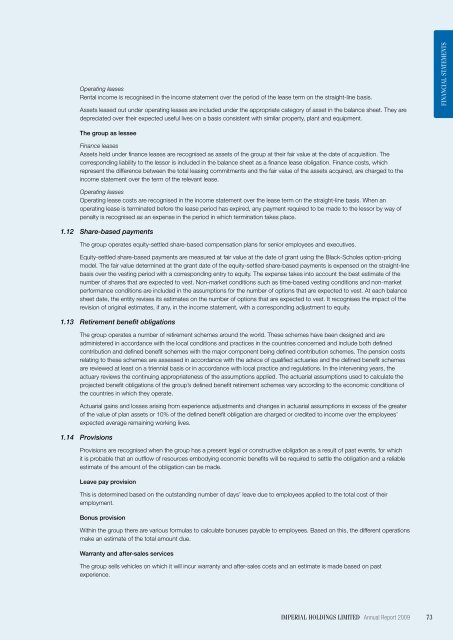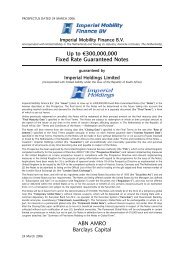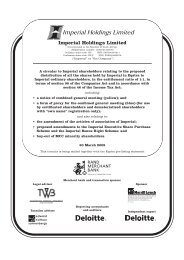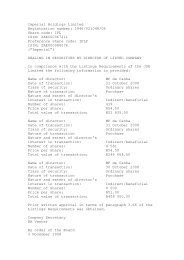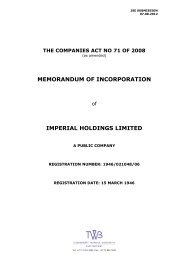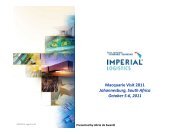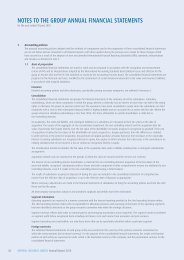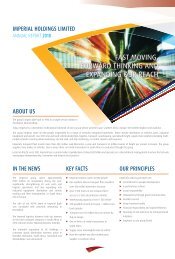4.0 - Imperial
4.0 - Imperial
4.0 - Imperial
You also want an ePaper? Increase the reach of your titles
YUMPU automatically turns print PDFs into web optimized ePapers that Google loves.
Operating leases<br />
Rental income is recognised in the income statement over the period of the lease term on the straight-line basis.<br />
Assets leased out under operating leases are included under the appropriate category of asset in the balance sheet. They are<br />
depreciated over their expected useful lives on a basis consistent with similar property, plant and equipment.<br />
Financial Statements<br />
The group as lessee<br />
Finance leases<br />
Assets held under finance leases are recognised as assets of the group at their fair value at the date of acquisition. The<br />
corresponding liability to the lessor is included in the balance sheet as a finance lease obligation. Finance costs, which<br />
represent the difference between the total leasing commitments and the fair value of the assets acquired, are charged to the<br />
income statement over the term of the relevant lease.<br />
Operating leases<br />
Operating lease costs are recognised in the income statement over the lease term on the straight-line basis. When an<br />
operating lease is terminated before the lease period has expired, any payment required to be made to the lessor by way of<br />
penalty is recognised as an expense in the period in which termination takes place.<br />
1.12 Share-based payments<br />
The group operates equity-settled share-based compensation plans for senior employees and executives.<br />
Equity-settled share-based payments are measured at fair value at the date of grant using the Black-Scholes option-pricing<br />
model. The fair value determined at the grant date of the equity-settled share-based payments is expensed on the straight-line<br />
basis over the vesting period with a corresponding entry to equity. The expense takes into account the best estimate of the<br />
number of shares that are expected to vest. Non-market conditions such as time-based vesting conditions and non-market<br />
performance conditions are included in the assumptions for the number of options that are expected to vest. At each balance<br />
sheet date, the entity revises its estimates on the number of options that are expected to vest. It recognises the impact of the<br />
revision of original estimates, if any, in the income statement, with a corresponding adjustment to equity.<br />
1.13 Retirement benefit obligations<br />
The group operates a number of retirement schemes around the world. These schemes have been designed and are<br />
administered in accordance with the local conditions and practices in the countries concerned and include both defined<br />
contribution and defined benefit schemes with the major component being defined contribution schemes. The pension costs<br />
relating to these schemes are assessed in accordance with the advice of qualified actuaries and the defined benefit schemes<br />
are reviewed at least on a triennial basis or in accordance with local practice and regulations. In the intervening years, the<br />
actuary reviews the continuing appropriateness of the assumptions applied. The actuarial assumptions used to calculate the<br />
projected benefit obligations of the group’s defined benefit retirement schemes vary according to the economic conditions of<br />
the countries in which they operate.<br />
Actuarial gains and losses arising from experience adjustments and changes in actuarial assumptions in excess of the greater<br />
of the value of plan assets or 10% of the defined benefit obligation are charged or credited to income over the employees’<br />
expected average remaining working lives.<br />
1.14 Provisions<br />
Provisions are recognised when the group has a present legal or constructive obligation as a result of past events, for which<br />
it is probable that an outflow of resources embodying economic benefits will be required to settle the obligation and a reliable<br />
estimate of the amount of the obligation can be made.<br />
Leave pay provision<br />
This is determined based on the outstanding number of days’ leave due to employees applied to the total cost of their<br />
employment.<br />
Bonus provision<br />
Within the group there are various formulas to calculate bonuses payable to employees. Based on this, the different operations<br />
make an estimate of the total amount due.<br />
Warranty and after-sales services<br />
The group sells vehicles on which it will incur warranty and after-sales costs and an estimate is made based on past<br />
experience.<br />
<strong>Imperial</strong> holdings limited Annual Report 2009 73


